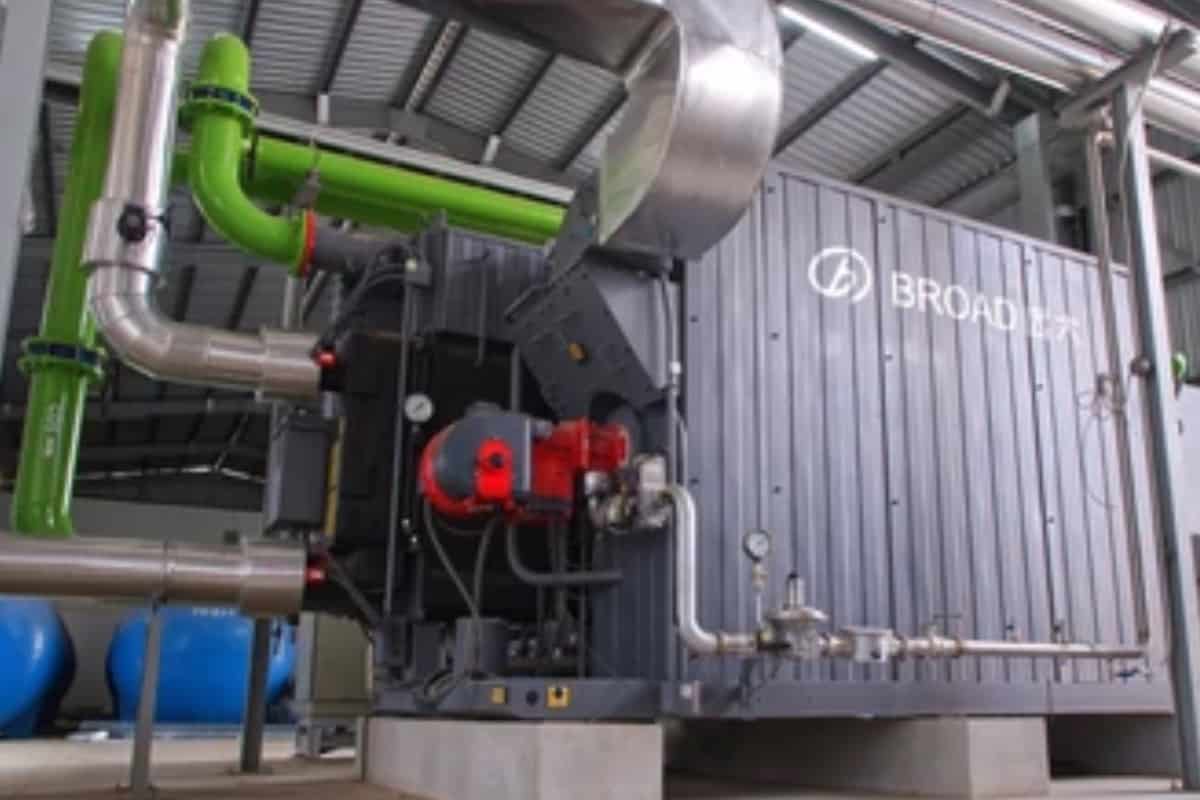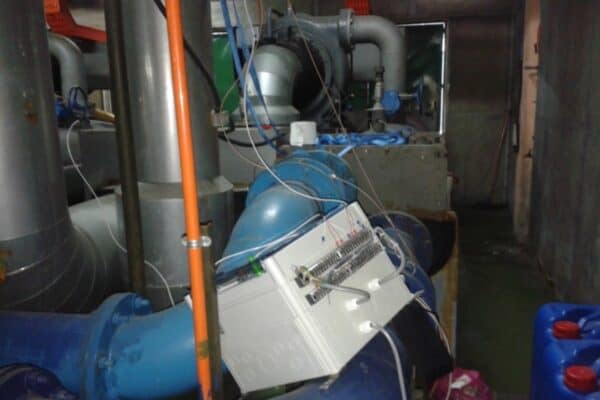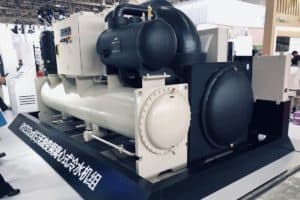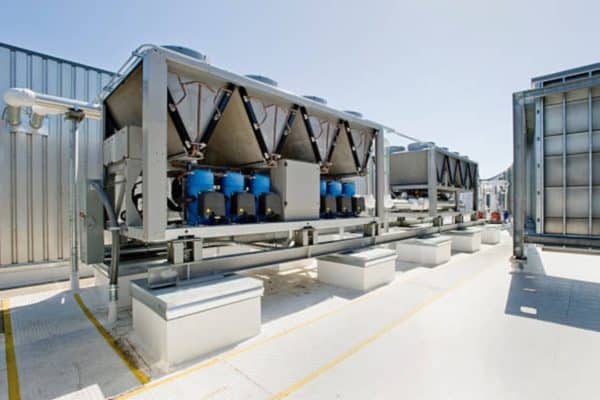How Absorption Chillers Work?
Absorption chillers used in Qatar’s world cup stadiums are powered by solar hot water which many HVAC engineers find it very interesting and inspiring. However, absorption chillers are not very well understood by people.
If you haven’t read my previous article about how Qatar air condition their open-air stadiums for the FIFA world cup, go see it here: Qatar World Cup Stadium Air Conditioning System.
Normally, chilled water is produced by water-cooled centrifugal or screw chillers. Sometimes, it is produced by air-cooled scroll or screw chillers, especially for smaller applications.
In a typical chilled water system, we have the chilled water loop and the condenser water loop. The former does heat absorption while the latter does heat rejection. In the case of water-cooled chillers, the heat rejection is done by cooling towers.
Whether it is a scroll, screw or centrifugal chiller (air-cooled or water-cooled), they all run on the vapor-compression refrigeration cycle where the 4 major components of the refrigeration cycle can be found: a) compressor, b) condenser, c) evaporator and d) expansion valve. At the same time, they all use HFC refrigerants such as R134a or R513A.
On the other hand, absorption chillers produce chilled water at similar temperatures but they don’t run on the vapor-compression refrigeration cycle.
Thus, absorption chillers don’t use refrigerants and they don’t have a compressor.
Instead, absorption chillers use a lithium bromide/water cycle, water as refrigerant and lithium bromide as absorbent. Totally different but interesting isn’t it?
How Absorption Chillers Work?
An absorption chiller has a high-pressure vessel (~5-6 kPa) that contains the generator and the condenser and a low-pressure vessel (~0.7 kPa) that contain the absorber and the evaporator.
The generator is where heat is introduced into the absorption chiller to separate water vapor from lithium bromide.
There are a few types of absorption chillers, namely: a) natural-gas fired, b) indirect-generated by steam or hot water and c) indirect-generated by exhaust gas. The name suggests how the absorption chiller is powered.
In the case of the Al Janoub Stadium, the absorption chillers are powered by solar hot water from the Al Kharsaah solar farm.
Typically, the hot water goes into the generator of absorption chillers has a temperature of around 88°C (190.4°F) and it leaves at around 72°C (161.6°F).
As the hot water circulates through the generator, it boils the refrigerant water in the lithium bromide/water solution.
Water in the lithium bromide/water solution is now referred to as refrigerant water to avoid confusion.
Water is able to boil with such hot water temperature because the boiling point is lowered due to the low vessel pressure. At 6 kPa, water boils at 35.6°C (96°F).
So, refrigerant water vapor is produced and it flows into the condenser where it is condensed back to liquid refrigerant water again because of the cooling tower water which typically enters the condenser at about 27°C (80.6°F) and leaves at about 32°C (89.6°F).
Remember that the generator and the condenser share the same vessel pressure and thus, the boiling point of water is also the same. Therefore, the cooling tower water temperature is enough to condense the refrigerant water vapor.
Therefore, absorption chillers do work with cooling towers just like conventional water-cooled chillers.
Once the water is condensed, the liquid water flows to the low-pressure vessel and goes into the evaporator. In the low-pressure vessel, the boiling point of water drops to 2.4°C (36.3°F).
Due to the sudden drop in pressure, the refrigerant water becomes very cold.
Meanwhile, the chilled water returned back to the absorption chiller at about 12°C (53.6°F) circulates through the evaporator and boil the refrigerant water again. Then, it leaves the evaporator at about 7°C (44.6°F).
Once again, refrigerant water vapor is produced in the evaporator and it flows to the absorber where it mixes with lithium bromide that comes back from the generator.
Afterward, the lithium bromide/water mixture is pumped into the generator and the cycle repeats.
See the below flow schematic of single-effect lithium bromide/water absorption chiller by ASHRAE to visualize how absorption chillers work:
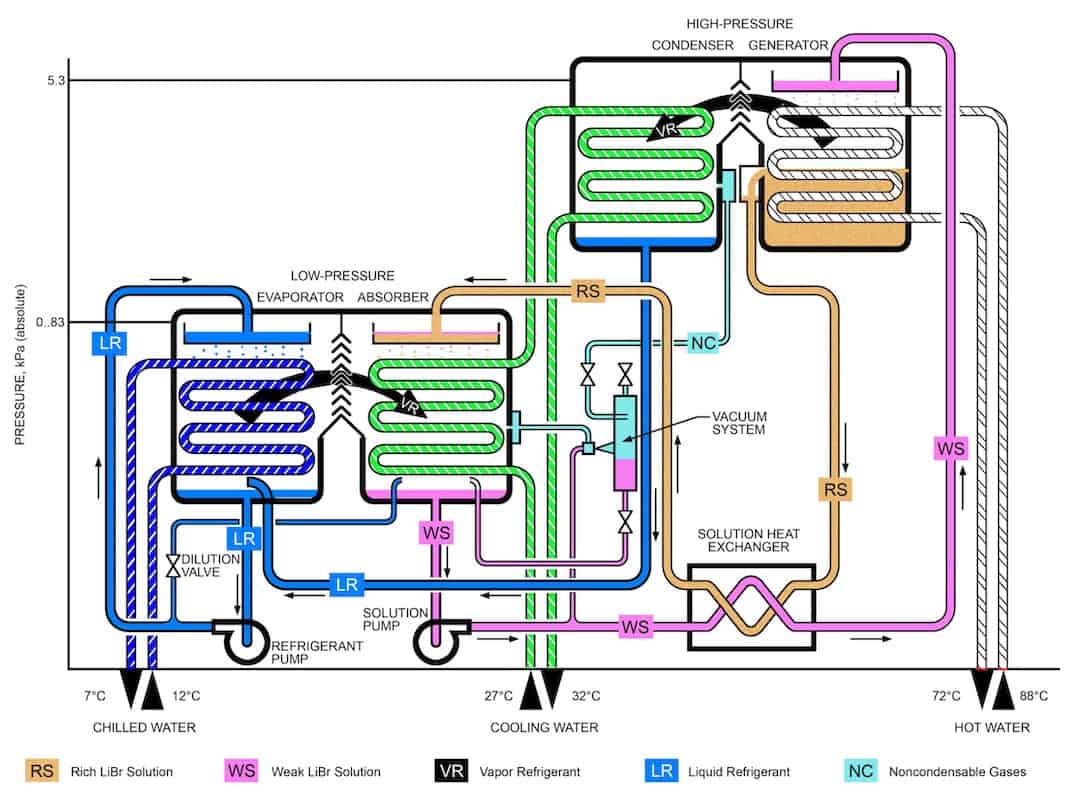
From the above schematic, a refrigerant pump is used to respray liquid refrigerant water (missed out the evaporation ones) back onto the chilled water tubes for evaporation.
The solution heat exchanger recovers heat from the rich lithium bromide solution to the weak lithium bromide solution to improve efficiency.
It is called the rich lithium bromide solution because less water is in the solution (boiled off at the generator). Similarly, it is called the weak lithium bromide solution because more water is in the solution (mixed back at the absorber).
So, this is how absorption chillers work. They use hot water to create refrigerant water vapor, use cooling tower water to condense the refrigerant water vapor into liquid refrigerant water, reduce its pressure to bring down its temperature and use chilled water to boil it again to continue the cycle.
Of course, this is a very surface explanation but you get the idea of how absorption chillers work. Now, more about absorption chillers in the following.
On a side note, if you want to quickly learn about chilled water system, you can get my Chilled Water System (eBook). If you’re into design, you can enroll in my Chilled Water System Design Course where I teach you various design procedures with tons of examples.
Chilled Water System Design Course
Learn how to design a chilled water system with AHU/FCU selection, chiller sizing, cooling tower sizing, pump sizing, piping design, ductwork design and more.
Benefits of Absorption Chillers
Absorption chillers not only can be powered directly by natural gas or indirectly by hot water, but they can also be powered by waste heat like hot exhaust gas from power plants. Such absorption chillers are sometimes known as heat recovery absorption chillers.
Compared to conventional air-cooled and water-cooled chillers, absorption chillers have a few benefits:
- Absorption chillers are powered by heat. Other than waste heat, absorption chillers can use hot water produced by solar like what Qatar did with their world cup stadiums to reduce operating cost.
- Absorption chillers don’t use HFC refrigerants that are harmful to the environment. Currently, everyone is talking about next-generation refrigerants like R32 and R513A that has a low GWP. Absorption chillers can just eliminate the use of those refrigerants.
- Absorption chillers don’t have a compressor. Not only peak demand is reduced but also lubricant which can degrade and reduce efficiency is not required anymore.
However, it is very tempting to burn low-cost natural gas to power absorption chillers which is not good for the environment. So far, I see solar hot water is pretty good.
Still, only specific places on earth have the privilege to harvest enough thermal energy from the sun to produce hot water at temperatures that are sufficient to power absorption chillers.
Perhaps, another type of absorption chiller which is called the Absorption Heat Transformer can be used in the middle to amplify heat before the actual absorption chiller.
Types of Absorption Chillers
Other than Absorption Chillers and Absorption Heat Transformers, the third equipment classified by ASHRAE is the Absorption Heat Pumps which can harvest heat from steam (200-600 kPa) and condenser water at 30°C (86°F) to produce hot water up to 90°C (194°F).
The hot water can be used for various applications such as kitchen dishwashers, bathroom hot water and even radiant heating via radiators like many houses in the UK.
Read about How Daikin Altherma Heat Pumps Work to provide hot water for domestic usage and space heating via radiators for houses in the UK.
Apart from that, absorption chillers also have the single-effect type and the double-effect type.
Basically, single-effect absorption chillers take in heat at a much lower temperature compared to double-effect absorption chillers (eg: 90°C hot water vs 160°C high-pressure steam). As a result, double-effect absorption chillers produce twice the output, as the name suggests.
Frequently Asked Questions
There are a few questions about absorption chillers that keep coming back to me. Well, answering these short FAQs is as good as providing a summary for this article.
Is Absorption Chiller a Heat Pump?
Normally, absorption “chiller” is referred to as a machine that produces chilled water (7°C or so). Whereas a “heat pump” is known as a machine that provides heating (either producing warm air or hot water). So, absorption chiller is not a heat pump. An absorption heat pump is a heat pump.
Do Absorption Chillers Have a Compressor?
Absorption chillers don’t use the vapor-compression refrigeration cycle. Thus, absorption chillers don’t have a compressor. Lithium bromide and water in absorption chillers move around by water pumps.
How Many Types of Absorption Chillers Are There?
In terms of equipment classification, there are three types of absorption chillers:
- Absorption Chillers – Produce chilled water for air conditioning using a high-temperature heat source.
- Absorption Heat Pumps – Used for heat recovery from low-temperature (ambient) heat sources to heat buildings.
- Absorption Heat Transformers – Generate high-temperature heat from intermediate-temperature waste sources.
Then, absorption chillers can be further categorized into single-effect or double-effect based on the design and heat source of the absorption chiller.
When it comes to the power, absorption chillers can also be separated into four types: 1) natural-gas fired, 2) indirect-generated by low-pressure steam, 3) indirect-generated by high-pressure steam or hot water and 4) indirect-generated by hot exhaust gas.
Do Absorption Chillers Use Electricity?
Although absorption chillers don’t have a compressor, they do use electricity. However, compared to conventional air-cooled and water-cooled chillers, absorption chillers use relatively less electricity. But, the total energy usage of the system depends on what is being used to power the absorption chiller.
Final Thought
Absorption chillers are something that I’m aware of but not really getting into it before Qatar’s world cup stadiums. Now that I’ve learned more about absorption chillers, especially the integration with solar water heating, I find that countries with similar climates as Qatar can really adopt it to achieve high energy efficiency and reduce carbon emission/footprint as much as possible.
Once again, you can get my Chilled Water System (eBook) to quickly learn more about chilled water system. But, if you want to learn how to design a chilled water system from start to end, I encourage you check out my Chilled Water System Design Course.
Chilled Water System Design Course
Learn how to design a chilled water system with AHU/FCU selection, chiller sizing, cooling tower sizing, pump sizing, piping design, ductwork design and more.
If you have anything to add (or ask) about this topic, leave a comment down below!


